It was the great Chicago fire of October 8, 1871 that inspired the creation of Greeley’s first fire department. As you know, the Chicago fire consumed, in less than a week roughly 3.5 square miles of the city and killed approximately 250 people. Greeley’s population by 1871 was about 1,500 and the town itself was an assortment of frame buildings which an Illinois journalist in 1870 described as “so many dry goods boxes scattered across the plains of the Almighty”, Greeley, Colorado Territory, was the perfect tender for a fire.
Henry T. West, the president of the Town Board, spearheaded the establishment of Greeley’s fire department, as his son’s home and business had been destroyed in the Chicago fire. By Nov. 6, 1871, Greeley had adopted an ordinance authorizing the town board to appoint a fire department to recruit members, maintain equipment, conduct inspections, and enforce fire codes. The city provided funds for a fire station and equipment, but relied on members of volunteer hose companies to fight fires until professional municipal firefighters were hired in 1913. Our City Directories list these companies and their captains.
These volunteer companies were called “hose companies” or “hook-and-ladder companies.” The Poudre Valley Hook and Ladder Company was sometimes called the “Poudre Valley Hooks” or the “Boomer Hooks” after its captain, William. M. Boomer. It was established in the 1870s and distinguished itself by winning a silver trophy belt and $100.00 in the August 10, 1886 state championship sponsored by the Colorado Firemen’s Association. Annual fireman’s balls were held as fund raising events for the volunteer companies so uniforms, equipment, etc. could be maintained and/or purchased.
The Greeley Tribune reported in its July 30, 1879 edition that a new hook and ladder truck had been purchased for $475.00, containing two 36-foot extension ladders, one long ladder and two short roof ladders, a hook with chain and roper, axes, six rubber buckets and other equipment. The first fire house in Greeley was a rented building at 719 7th Street. A tower with a fire bell suspended from it was placed in the back of the building.
Later, the old fire-bell was erected on a tower at the northwest corner of 9th Avenue and 7th Street, the site of the one-story frame structure which served as Greeley's first City Hall. According to an article in The Greeley Tribune, August 29, 1946, “When the bell was rung to indicate a fire, the volunteers would dash from their businesses to the fire station near the Camfield Hotel. They would run with the hook-and-ladder and hose carts to the fire, usually the whole town running after them! Even the sons of the volunteer firemen were enlisted in the service and had the privilege of dashing from the school room when the fire bell rang, in spite of protests by the teachers. The sons' duty at a fire was to pass out the rubber coats to the firemen. Louis Horne recalled the time one boy, by mistake, gave the white coat, reserved for the fire chief, to one of the firemen in the ranks. The fire became secondary to the pandemonium that ensued.”
The town purchased a Silsbey Steamer ca. 1884 or 1885. The Silsbey Company was later purchased and became part of the American LaFrance fire apparatus company. Initially assigned to this new steamer as engineer and assistant engineer, respectively, were Menzo Mattison who was an engineer at the Greeley flour mill and E.L. Dunham, a jeweler.
From an article in the October 17, 1930 Greeley Tribune, is the following information on the steamer, as recalled by Frank M. Barber, who was a Greeley alderman at the time:
“I came here in 1883, when the town board was considering the purchase of a steamer. I’m sure that it very shortly bought a Silsby, a very fine and powerful machine. I joined the steamer company at once. I believe that the city had an agreement with Joe Beetham, who ran a delivery wagon, to rush his team to the fire house on any alarm, and take the engine to the fire. The engine pump had a great deal of power. I believe it could put a stream of water 150 feet into the air. I remember when the nozzleman knocked the hat off a drunken man, and the water carried the hat 50 feet into the air. When asked if the fireman kept up steam all the time, Barber said that the firebox was always ready to kindle, the fuel probably soaked in kerosene. Tom Noon slept in the fire station, and on an alarm would light the fire under the boiler. By the time the steamer got to the fire, steam was up to run the pumps.”
According to an article written in the January 16, 1946 Greeley Tribune, the steamer, “…like many another beauty, did not live up to expectations. She burned wood in her boilers and it took such a long time to get up enough steam necessary to force water from 20-foot wells dug at the intersection of streets and avenues in the business section, thru her hose that the fire was usually out or the building burned to the ground before she was working properly.”
From the Greeley Tribune, January 6, 1886, is an article describing the “Good Work by the Fire Department” in fighting the fire which destroyed J.B. Flower's frame building located at the corner of 8th and 8th:
“This evening, about half-past nine and when The Tribune forms were almost ready for press, the fire-alarm was rung by night-watchman Drown for a fire that had attained considerable headway in the rear of Flower's frame building corner of Main Street and Eighth Avenue.
“The firemen turned out promptly, or at least those who happened to hear the bell, which, owing to its cracked condition, emitted a very weak and uncertain sound, so that many who lived several blocks distant did not hear it at all and only became aware that a fire was raging when they heard the steamer working, and saw the light from the fire. The engine was soon at work, Tom Noons having steam ready as soon as connection could be made with the hose. At first it looked as if the fire would be stayed and the building saved. This was quickly seen to be a mistake, as the flames burst forth furiously between Igo's store and the drug store, and all that could then be done was to prevent the fire extending to adjoining buildings.
“This was successfully accomplished, the steamer throwing three powerful streams and the hose from the Oasis doing good work.
“All this time the Hook and Ladder boys were rendering all the aid in their power, and by 1 o'clock the fire was so far quenched, that Chief Abbott thought it would be safe to leave it, details from the Hooks and the Steamer companies being left to keep watch and the engine kept in readiness at the engine house for immediate service in case of necessity. This proved a wise precaution, for in about an hour the flames again burst forth from the ruins of the shed next to the alley, and an alarm quickly brought the boys again to the fire and the flames were quickly subdued, but owing to the high wind it was thought best to continue throwing water on the ruins, as it was evident that there was considerable fire that might break out again at any moment. Officers and members of the company worked with a will, notwithstanding the weather was piercingly cold with a keen and biting wind that rendered constant care necessary to keep fingers and ears from freezing. Even the steam gauges on the engine had to be closely watched to prevent freezing.
“Chief Abbott was present from the start, and proved himself the right man in the right place; and he was ably seconded in his efforts by Messrs. Boomer and Camp, foremen respectively of the Hooks and the Steamer Companies. Those persons who have ridiculed the need of a steam fire engine, we presume were thoroughly convinced last night, that it did some good. Without it the prospect was good for an extensive conflagration; with it the fire was prevented from extending beyond the buildings in which it started. At this hour it is impossible to get exact figures of losses. Mr. Igo was insured about $8,000 on stock and thinks it may cover his loss. Flower & Petriken’s stock was insured for about $7,300 which is not likely to cover damages. Mr. Barton is probably the greatest sufferer, but to what extent is not yet known. Mr. Hallet saved almost all of his stock of boots and shoes. The total loss is probably somewhere between $25,000 and $30,000. During the fire, Sharon Atkinson, who was on the roof on one of the buildings, slipped off and received some injury in the leg. An examination revealed no fracture, but rather a severe sprain.
“Dr. Hawes attended him. No other accidents occurred, so far as we can learn, except to a coyote, which being tied to a wagon was quickly dispatched by the revolving wheel, when the wagon was needed to remove some of the goods that had been saved. The origin of the fire is not yet known. Captain Howard, of the Oasis, kindly supplied the firemen with hot coffee during the night, which was thoroughly appreciated by the boys.”
From The Greeley Tribune, January 13, 1886, the following information is supplied about the above fire: “Owing to the intense cold on the night of the fire, several of the firemen had their face and ears badly frozen, causing them severe pain for several days after. Quite a number also caught severe colds as a result of getting thoroughly wet. The weather that night was altogether the worst experienced this winter, the mercury ranging from nine to eighteen below zero, with a keen wind blowing.”
On August 10, 1886, the Poudre Valley Hooks, No. 1 of Greeley, Colorado, won the state championship sponsored by the Colorado Firemen’s Association.
From The Greeley Tribune, November 27, 1878: “Just as we go to press, we learn that the barn of Sharon Atkinson was destroyed by fire last night, together with everything it contained, including a team of horses, a through-bred bull, hogs, grain, wagons, and farming implements. The house was saved.”
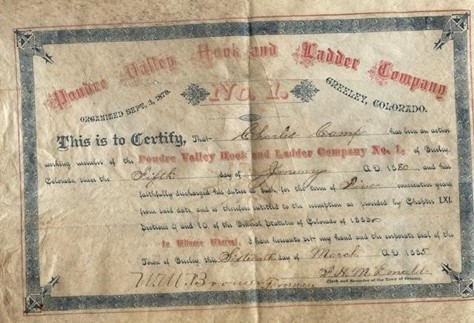

The two photos above show certificates given to Charles Camps of the Poudre Valley Hook and Ladder Company signed by WM Boomer and the J.L. Brush Hose Co. No. 1, given to JL McCarter.
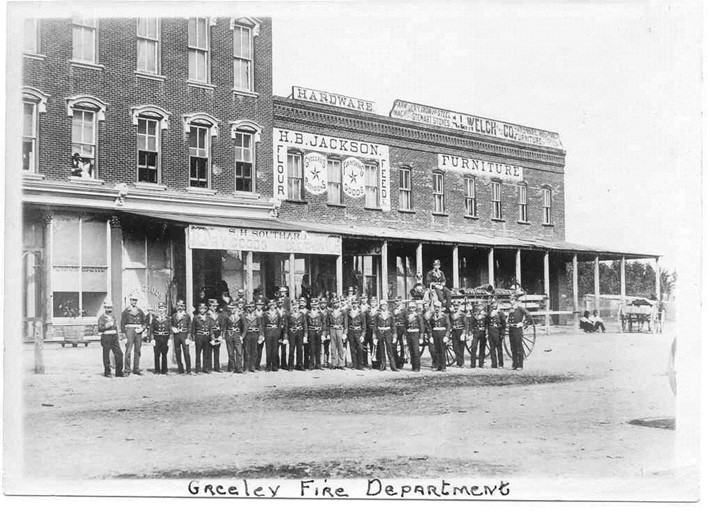
Pictured above, the Poudre Valley Hook and Ladder Company taken in the 1880’s. Picture shows the west side of 8th Avenue between 7th and 8thStreet.
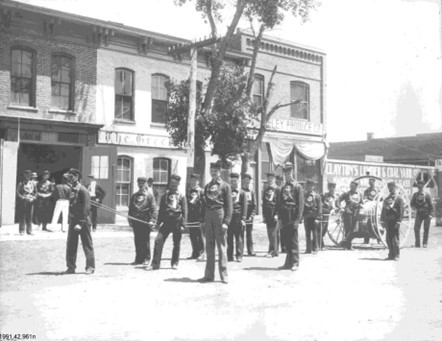
The J.L. Brush Hose Company No 1. Photo taken late 1880’s. This view shows the north side of 7th Street between 8th and 7th Aves. The buildings, left to right: The fire department, The Greeley Tribune, The Greeley Produce Company, and Clayton’s Lumber and Coal Yard.
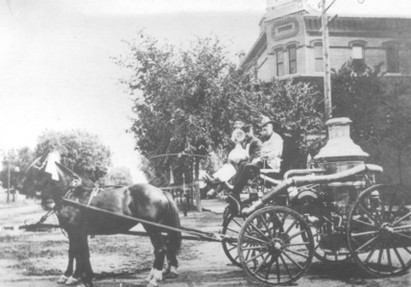
Capt. Thomas Macy with steamer at 8th Avenue and 7th Street.
In 1911, George Venables was appointed fire chief of the city by the Greeley City Council. The volunteer companies listed above were incorporated as the volunteer fire department of the city. The volunteer companies had always elected its fire chiefs and assistant chiefs, and were quite unhappy when Mr. Venables was appointed chief, as they had all voted for Charles W. Beer to be their chief. The volunteer companies were very upset and voted unanimously not to participate in fighting fires unless Mr. Venables was dismissed as chief. Shortly thereafter, the City of Greeley, not wishing to be without fire protection, hired fire fighters and the era of volunteer fire fighters in the City of Greeley ended. In 1913 the Greeley Fire Department became a fully paid organization.
In November of 1936, the Greeley Fire Department suffered its first line of duty death. Fireman Roy Nusbaum was killed in action when the saddle tank of a gasoline truck ruptured and ignited. He was severely burned while operating at the corner of 8th Avenue and 16th Street. Several other firemen were burned while assisting Fireman Nusbaum.
By 1950 the Greeley Fire Department was responding to over 200 incidents a year and the need for a second fire station was realized. A unanimous vote by City Council placed the next fire station at “Inspiration Point” near UNC’s student center at the recommendation of the Insurance Underwriters Organization. However, many residents did not like this location and presented City Council with petitions signed by over 250 residents. The fire station was later moved to its current location at 23rd Avenue and Reservoir Road. Construction was completed in 1958.

Members of the Greeley Fire Department. Mid 1960’s
The early 1970’s showed increase growth to the west side and the need for another fire station was realized in 1973. Greeley Fire was responding to close to 1,000 calls a year from two fire stations. Fire Station #3 was constructed and completed at 4400 10th Street and staffed and operational in mid 1974.

Maintenance on 1954 Peter Pirsch inside new Fire Station #3.
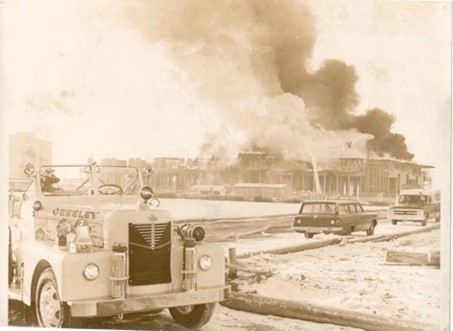
1954 Peter Pircsh fire engine operating at the Michener Library fire in 1970.
Increased railroad traffic and expansion to the east side of Greeley drove the need to have a fire station located on the east side of the rail line near 8th Avenue. In 1979 construction and staffing of Fire Station #4 was completed. In 1979 Greeley Fire was responding to over 1,600 incidents each year.
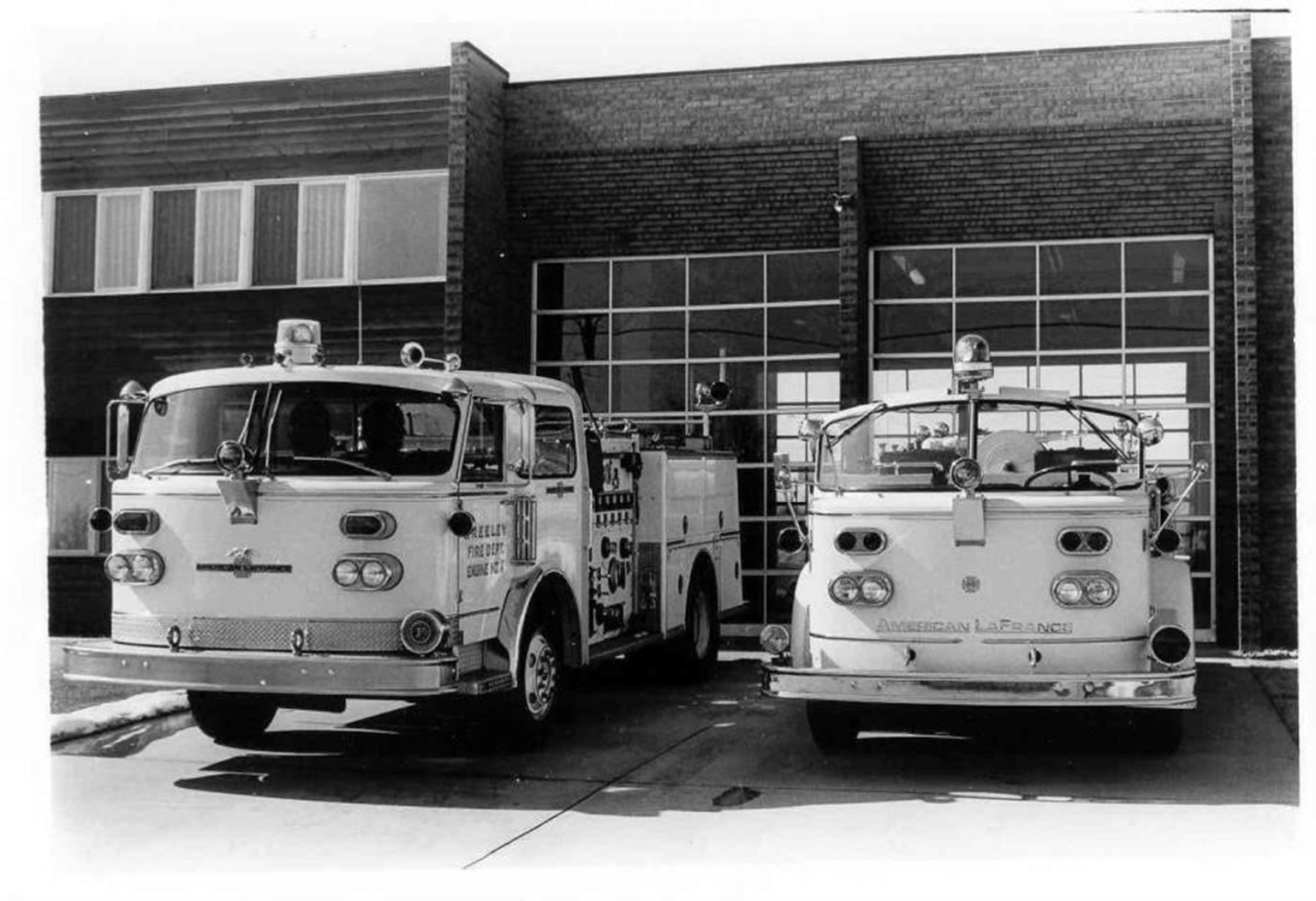
Fire Station 4, 1982. 1978 American LaFrance (L), 1970 American LaFrance(R)
In January of 1997, by an Inter-governmental Agreement (IGA) between the Greeley Fire Department and the Western Hills Fire Protection District, we became the Union Colony Fire/Rescue Authority. After nearly 13 years, the Authority was officially dissolved in December of 2010 and we once again became the Greeley Fire Department.
Station 5 was opened in 1999, Station 7 opened in 2002, and Station 6 came online in October of 2020.
On February 27, 2009, we experienced the tragedy of a second line of duty death when Lieutenant Brion Newkirk passed away from complications following back surgery from an on-duty injury.
Today, the Greeley Fire Department (GFD) provides service to 64.5 square miles and service a population of approximately 115,000 residents. In 2022, the department responded to over 17,000 calls for service.
